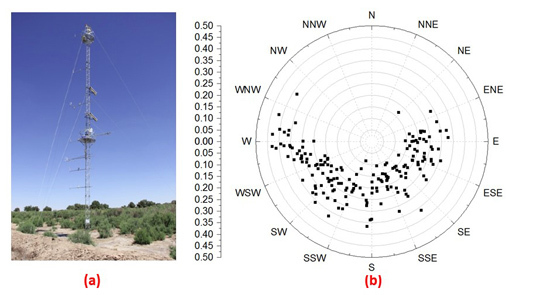Sensitivity of BRDF, NDVI and Wind Speed to the Aerodynamic Roughness Length over Sparse Tamarix in the Downstream Heihe River Basin
Abstract
:1. Introduction
2. Research Site and Experiments
3. Methodology
3.1. Introduction to the Indices
3.1.1. NDVI
3.1.2. BRDF_R Index
3.1.3. Combined Index of Wind Speed and NDVI
3.1.4. Combined Index of Wind Speed and NIR BRDF_R
3.2. Field Aerodynamic Roughness Length Calculation
4. Results and Analysis
4.1. Consistency Analysis of the Observed Data
4.2. Trend Analyses of the Indicators
4.3. Relationship Analyses
4.4. Regional z0m
5. Discussion
5.1. The Rationality of z0m
5.2. The Relationship between Wind Speed and z0m at Si Daoqiao
5.3. The Difference with Farmland and Grassland
6. Conclusions
Acknowledgments
Author Contributions
Conflicts of Interest
References
- Blumberg, D.G.; Greeley, R. Field studies of aerodynamic roughness length. J. Arid Environ. 1993, 25, 39–48. [Google Scholar] [CrossRef]
- Monteith, J. Principles of Environmental Physics; Edward Arnold: London, UK, 1973. [Google Scholar]
- Stull, R.B. An Introduction to Boundary Layer Meteorology; Springer: New York, NY, USA, 1988. [Google Scholar]
- Nichols, W.D. Energy budgets and resistances to energy transport in sparsely vegetated rangeland. Agric. For. Meteorol. 1992, 60, 221–247. [Google Scholar] [CrossRef]
- Mackinnon, D.J.; Clow, G.D.; Tigges, R.K.; Reynolds, R.L.; Chavez, P.S., Jr. Comparison of aerodynamically and model-derived roughness lengths (Z0) over diverse surfaces, central Mojave Desert, California, USA. Geomorphology 2004, 63, 103–113. [Google Scholar] [CrossRef]
- Driese, K.L.; Reiners, W.A. Aerodynamic roughness parameters for semi-arid natural shrub communities of Wyoming, USA. Agric. For. Meteorol. 1997, 88, 1–14. [Google Scholar] [CrossRef]
- Marticorena, B.; Kardous, M.; Bergametti, G.; Callot, Y.; Chazette, P.; Khatteli, H.; Hegarat-Mascle, S.L.; Maille, M.; Rajot, J.L.; Vidal-Madjar, D.; et al. Surface and aerodynamic roughness in arid and semiarid areas and their relation to radar backscatter coefficient. J. Geophys. Res. 2006, 111, F03017. [Google Scholar] [CrossRef]
- Martano, P. Estimation of surface roughness length and displacement height from single-level sonic anemometer data. J. Appl. Meteorol. 2000, 39, 708–715. [Google Scholar] [CrossRef]
- Allen, R.G.; Tasumi, M.; Morse, A.; Trezza, R.; Wright, J.L.; Bastiaanssen, W.; Kramber, W.; Lorite, I.; Robison, C.W. Satellite-based energy balance for mapping evapotranspiration with internalized calibration (METRIC)—Model. J. Irrig. Drain. Eng. 2007, 133, 395–406. [Google Scholar] [CrossRef]
- Bastiaanssen, W.G.M.; Menenti, M.; Feddes, R.A.; Holtslag, A.A.M. A remote sensing surface energy balance algorithm for land (SEBAL)—1. Formulation. J. Hydrol. 1998, 212–213, 198–212. [Google Scholar] [CrossRef]
- Jaeil, C.; Shin, M.; Pat, J.F.Y.; Wonsik, K.; Shinjiro, K.; Taikan, O. Testing the hypothesis on the relationship between aerodynamic roughness length and albedo using vegetation structure parameters. Int. J. Biometeorol. 2012, 56, 411–418. [Google Scholar] [CrossRef]
- Jordan, S.B.; Michael, F.J.; Richard, D.C. Time series vegetation aerodynamic roughness fields estimated from modis observations. Agric. For. Meteorol. 2005, 135, 252–268. [Google Scholar] [CrossRef]
- Schaudt, K.J.; Dikinson, R.E. An approach to deriving roughness length and zero-plane displacement height from satellite data, prototyped with BOREAS data. Agric. For. Meteorol. 2000, 104, 143–155. [Google Scholar] [CrossRef]
- Wu, B.F.; Xing, Q.; Yan, N.N.; Zhu, W.W.; Zhuang, Q.F. A linear relationship between temporal multiband MODIS BRDF and aerodynamic roughness in HiWATER wind gradient data. IEEE Geosci. Remote Sens. Lett. 2015, 12, 507–511. [Google Scholar] [CrossRef]
- Vermote, E.; Justice, C.O.; Bréon, F.M. Towards a generalized approach for correction of the BRDF effect in MODIS directional reflectance. IEEE Trans. Geosci. Remote Sens. 2009, 47, 898–908. [Google Scholar] [CrossRef]
- Roujean, J.L.; Leroy, M.; Deschamps, P.Y. A bidirectional model of the Earth’s surface for the correction of remote sensing data. J. Geophys. Res. 1992, 97, 20455–20468. [Google Scholar] [CrossRef]
- Xing, Q.; Wu, B.F.; Yan, N.N.; Yu, M.Z.; Zhu, W.W. Evaluating the relationship between field aerodynamic roughness and the MODIS BRDF, NDVI, and wind speed over grassland. Atmosphere 2017, 8, 16. [Google Scholar] [CrossRef]
- Yu, M.Z.; Wu, B.F.; Yan, N.N.; Xing, Q.; Zhu, W.W. A method for estimating the aerodynamic roughness length with NDVI and BRDF signatures using multi-temporal Proba-V data. Remote Sens. 2017, 9, 6. [Google Scholar] [CrossRef]
- Li, X.; Cheng, G.D.; Liu, S.M.; Xiao, Q.; Ma, M.G.; Jin, R.; Che, T.; Liu, Q.H.; Wang, W.Z.; Qi, Y.; et al. Heihe Watershed Allied Telemetry Experimental Research (HiWATER): Scientific objectives and experimental design. Bull. Am. Meteorol. Soc. 2013, 94, 1145–1160. [Google Scholar] [CrossRef]
- Li, X.; Liu, S.M.; Liu, Q.H.; Ma, M.G.; Xiao, Q.; Jin, R.; Che, T.; Wang, W.Z.; Qi, Y.; Guo, J.W.; et al. Implementation Plan of the Heihe Watershed Allied Telemetry Experimental Research (HiWATER); Cold and Arid Regions Environmental and Engineering Research Institute, Chinese Academy of Sciences: Lanzhou, China, 2012. [Google Scholar]
- Li, Z.S.; Jia, L.; Hu, G.C.; Lu, J.; Zhang, J.X.; Chen, Q.T.; Wang, K. Estimation of growing season daily ET in the middle stream and downstream areas of the Heihe River Basin using HJ-1 data. IEEE Geosci. Remote Sens. 2015, 12, 948–952. [Google Scholar] [CrossRef]
- Zhu, W.W.; Wu, B.F.; Yan, N.N.; Feng, X.; Xing, Q. A method to estimate diurnal surface soil heat flux from MODIS data for a sparse vegetation and bare soil. J. Hydrol. 2014, 511, 139–150. [Google Scholar] [CrossRef]
- Liu, S.M.; Xu, Z.W.; Zhu, Z.L.; Jia, Z.Z.; Zhu, M.J. Measurements of evapotranspiration from eddy-covariance systems and large aperture scintillometers in the Hai River Basin, China. J. Hydrol. 2013, 487, 24–38. [Google Scholar] [CrossRef]
- Liu, S.M.; Xu, Z.W.; Wang, W.Z.; Bai, J.; Jia, Z.; Zhu, M.; Wang, J.M. A comparison of eddy-covariance and large aperture scintillometer measurements with respect to the energy balance closure problem. Hydrol. Earth Syst. Sci. 2011, 15, 1291–1306. [Google Scholar] [CrossRef]
- MODIS Characterization Support Team. MODIS 1km Calibrated Radiances Product; NASA MODIS Adaptive Processing System, Goddard Space Flight Centre: Greenbelt, MD, USA, 2015.
- LAADS DAAC. Available online: https://ladsweb.modaps.eosdis.nasa.gov/ (accessed on 20 May 2017).
- Vermote, E.; Justice, C.; Claverie, M.; Franch, B. Preliminary analysis of the performance of the Landsat 8/OLI land surface reflectance product. Remote Sens. Environ. 2016, 185, 46–56. [Google Scholar] [CrossRef]
- EarthExplorer. Available online: https://earthexplorer.usgs.gov/ (accessed on 10 July 2017).
- Schaaf, C.; Liu, J.C.; Gao, F.; Jiao, Z.T.; Shuai, Y.M.; Strahler, A. MCD43B1—MODIS/Terra+Aqua BRDF/Albedo Model Parameters 16-Day L3 Global 1km SIN Grid, C5, NASA Level-1 and Atmosphere Archive & Distribution System (LAADS) Distributed Active Archive Centre (DAAC); Goddard Space Flight Centre: Greenbelt, MD, USA, 2015.
- Panofsky, H.A. Determination of stress from wind and temperature measurements. Q. J. R. Meteorol. Soc. 1963, 89, 85–94. [Google Scholar] [CrossRef]
- Zhou, Y.L.; Ju, W.M.; Sun, X.M.; Wen, X.F. Significant decrease of uncertainties in sensible heat flux simulation using temporally variable aerodynamic roughness in two typical forest ecosystems of China. J. Appl. Meteorol. Climatol. 2012, 51, 1099–1110. [Google Scholar] [CrossRef]
- Raupach, M.R. Drag and drag partition on rough surfaces. Bound.-Layer Meteorol. 1992, 60, 375–395. [Google Scholar] [CrossRef]
- Raupach, M.R. Simplified expressions for vegetation roughness length and zero-plane displacement as functions of canopy height and area index. Bound.-Layer Meteorol. 1994, 71, 211–216. [Google Scholar] [CrossRef]
- Zhou, Y.L.; Sun, X.M.; Zhu, Z.L.; Zhang, R.H.; Tian, J.; Liu, Y.F.; Guan, D.X.; Yuan, G.F. Surface roughness length dynamic over several different surfaces and its effects on modelling fluxes. Sci. China Ser. D 2006, 49, 262–272. [Google Scholar] [CrossRef]
- Faivre, R.; Colin, J.; Menenti, M. Evaluation of Methods for aerodynamic roughness length retrieval from very high-resolution imaging LIDAR observations over the Heihe Basin in China. Remote Sens. 2017, 9, 63. [Google Scholar] [CrossRef]
- Zhang, Q.; Zeng, J.; Yao, T. Interaction of aerodynamic roughness length and wind flow conditions and its parameterization over vegetation surface. Chin. Sci. Bull. 2012, 57, 1559–1567. [Google Scholar] [CrossRef]
- Langensiepen, M. Quantifying the uncertainties of transpiration calculations with the Penman—Monteith equation under different climate and optimum water supply conditions. Agric. For. Meteorol. 2009, 149, 1063–1072. [Google Scholar] [CrossRef]
- Sáncheza, J.M.; Caselles, V.; Niclòs, R.; Coll, C.; Kustas, W.P. Estimating energy balance fluxes above a boreal forest from radiometric temperature observations. Agric. For. Meteorol. 2009, 149, 1037–1049. [Google Scholar] [CrossRef]
- Kljun, N.; Calanca, P.; Rotach, M.W.; Schmid, H.P. A simple two-dimensional parameterization for Flux Footprint Prediction (FFP). Geosci. Model Dev. 2015, 8, 3695–3713. [Google Scholar] [CrossRef]
- Schott, R. Investigations on the Energy Balance Components in the Atmospheric Boundary Layer on the Example of a Pine Stock in the Upper Rhine Plain (Hartheim/Rhein); German Weather Service: Frankfurter, Germany, 1980. [Google Scholar]
- Vogt, R.; Jaeger, L. Evaporation from a pine forest. Using the aerodynamic and Bowen ratio method. Agric. For. Meteorol. 1990, 50, 39–54. [Google Scholar] [CrossRef]
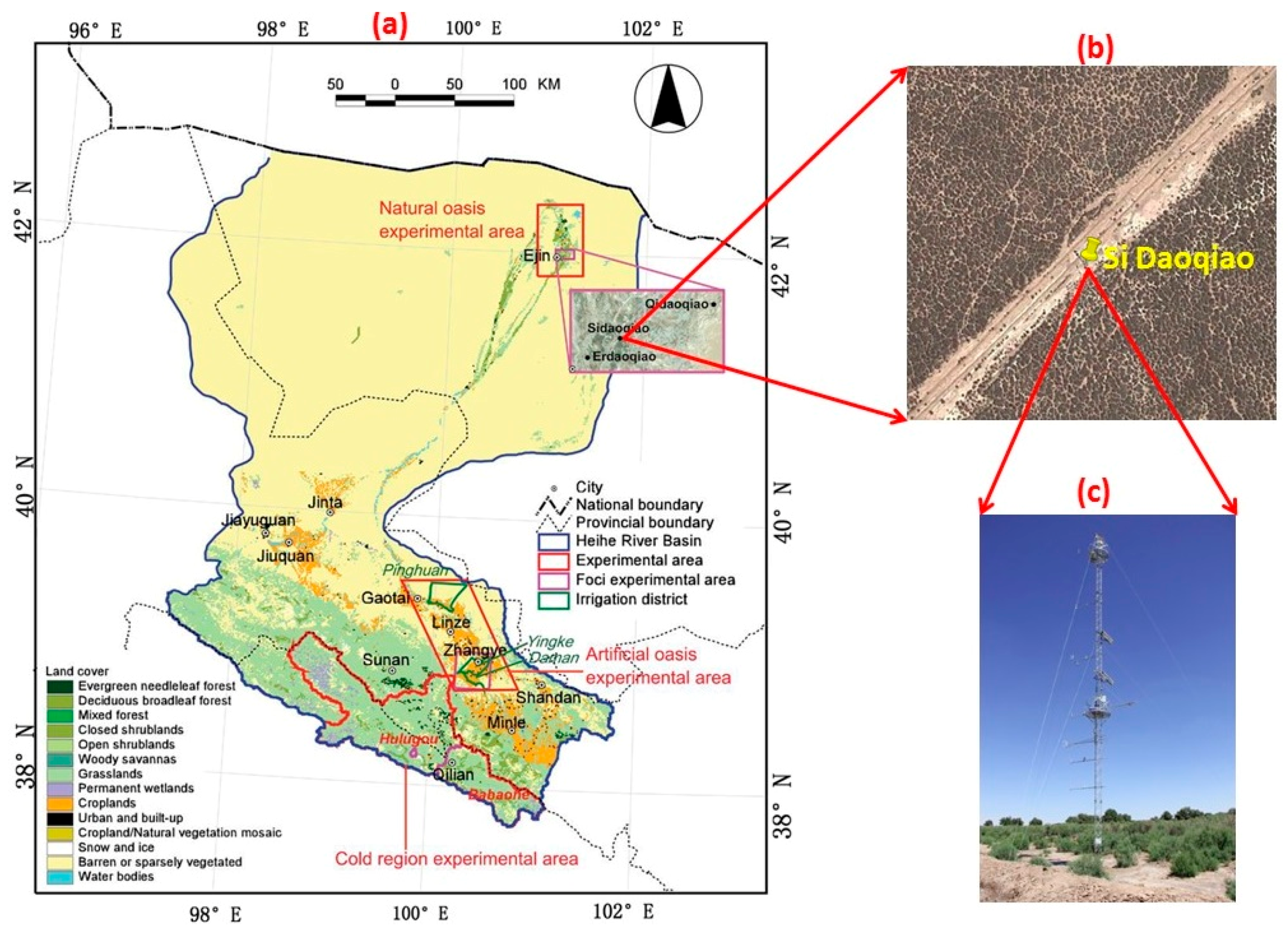
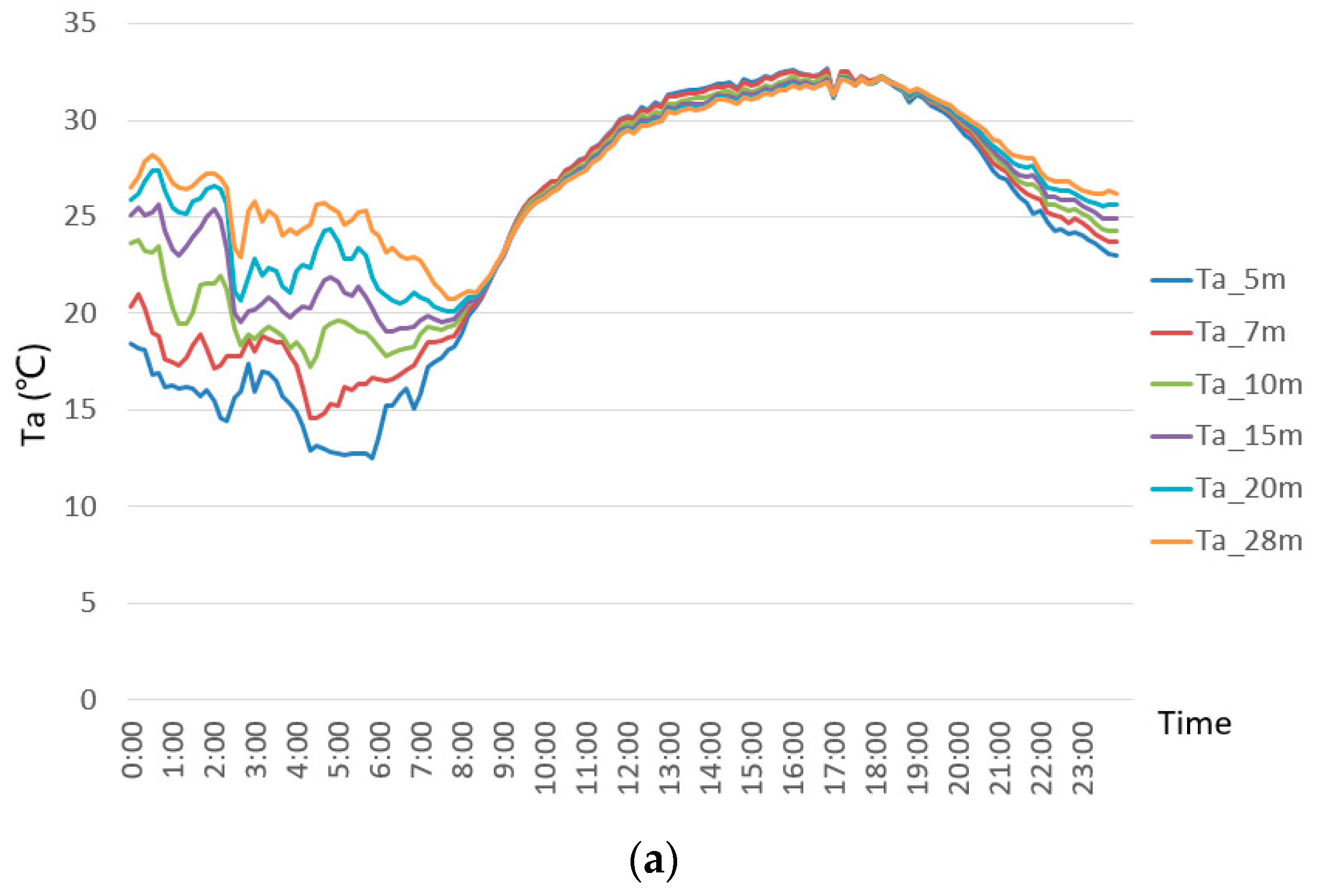

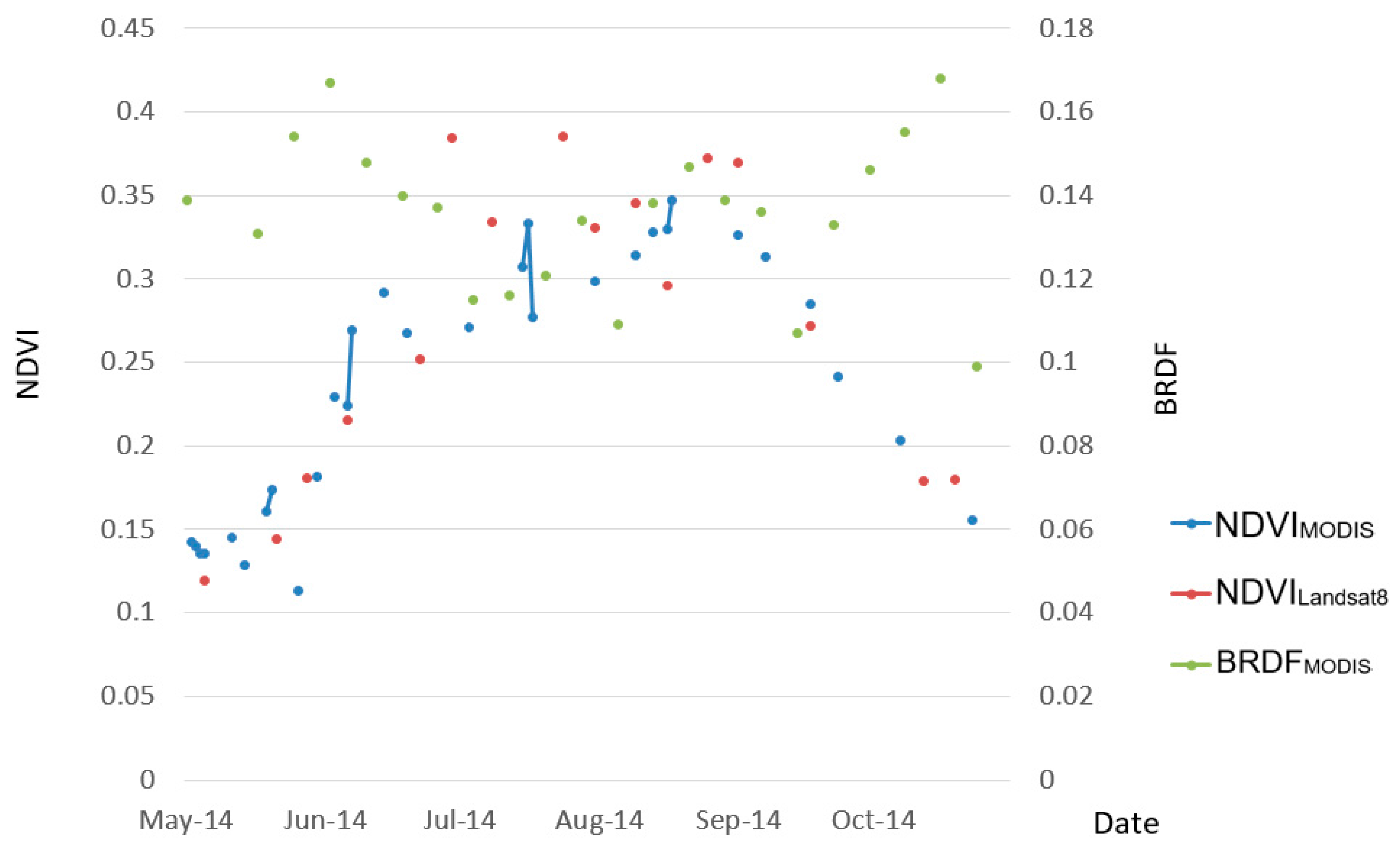
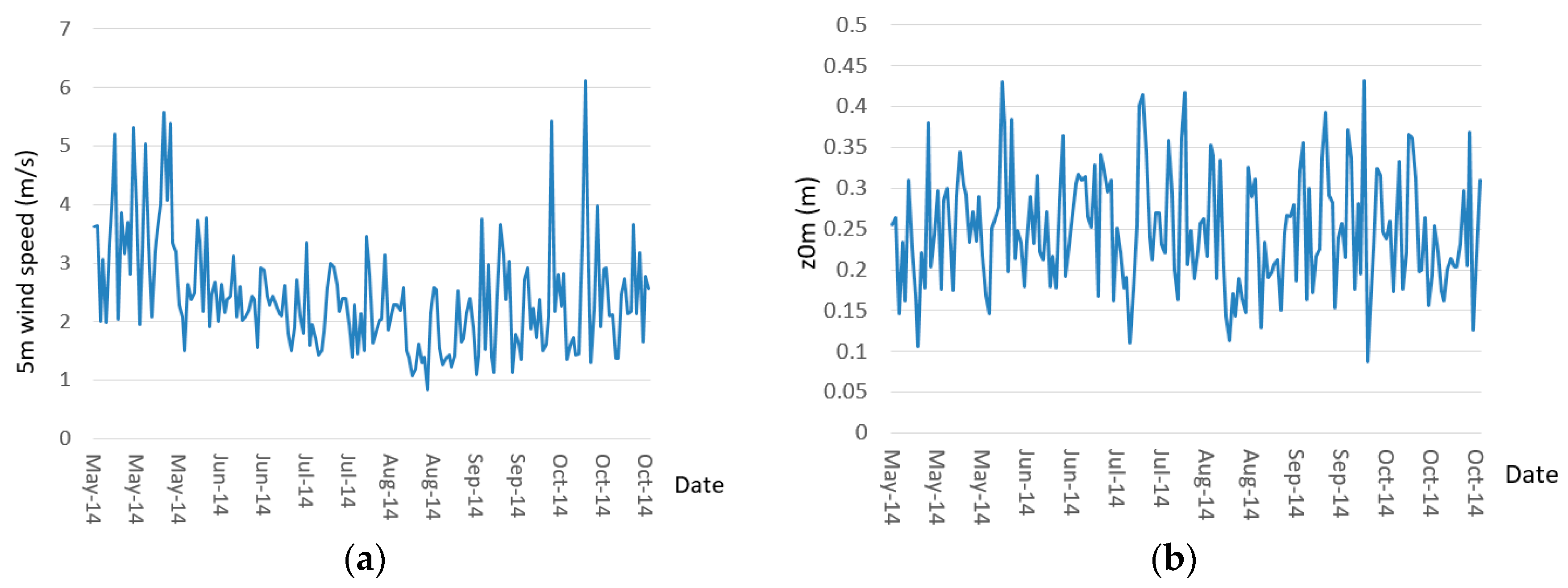

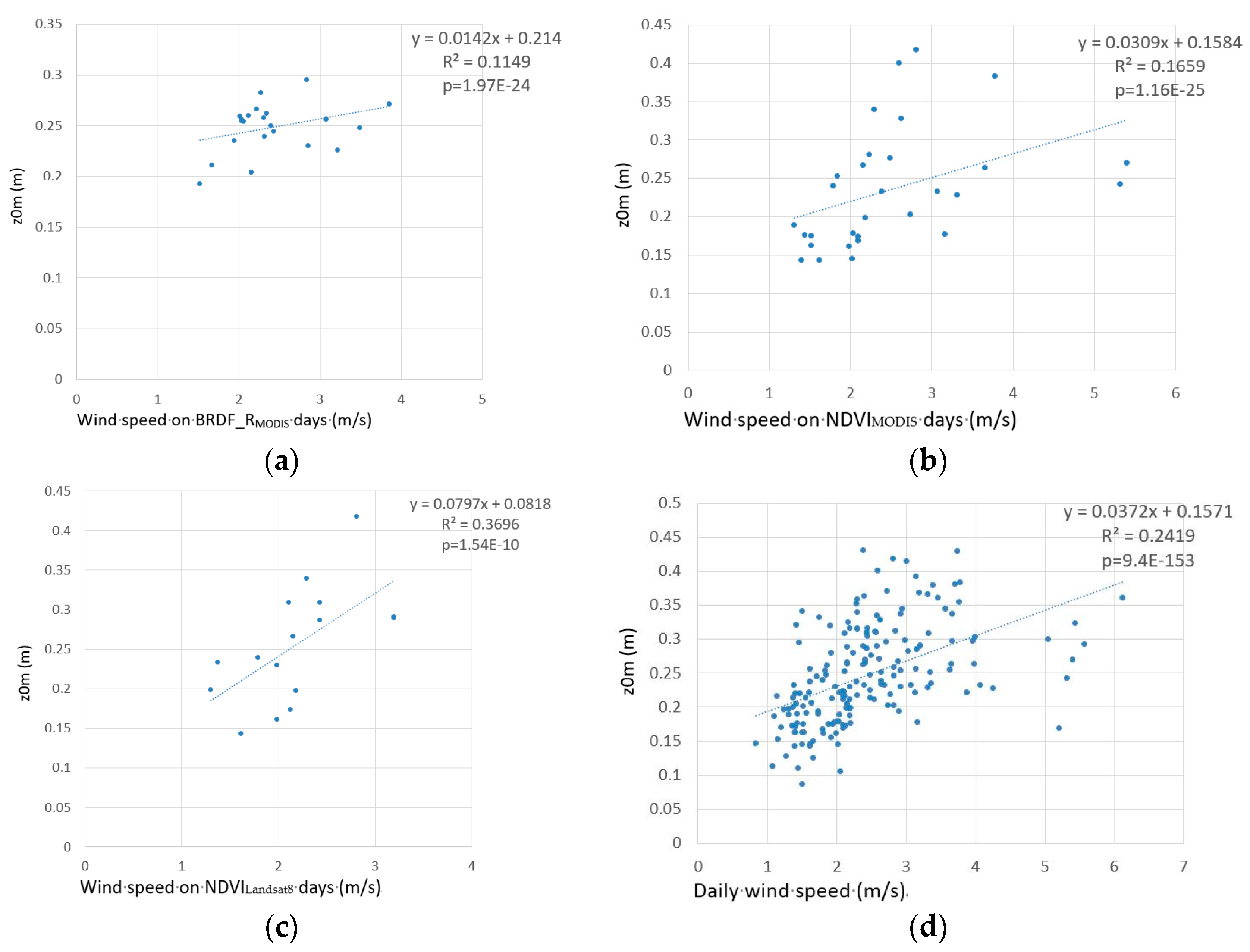
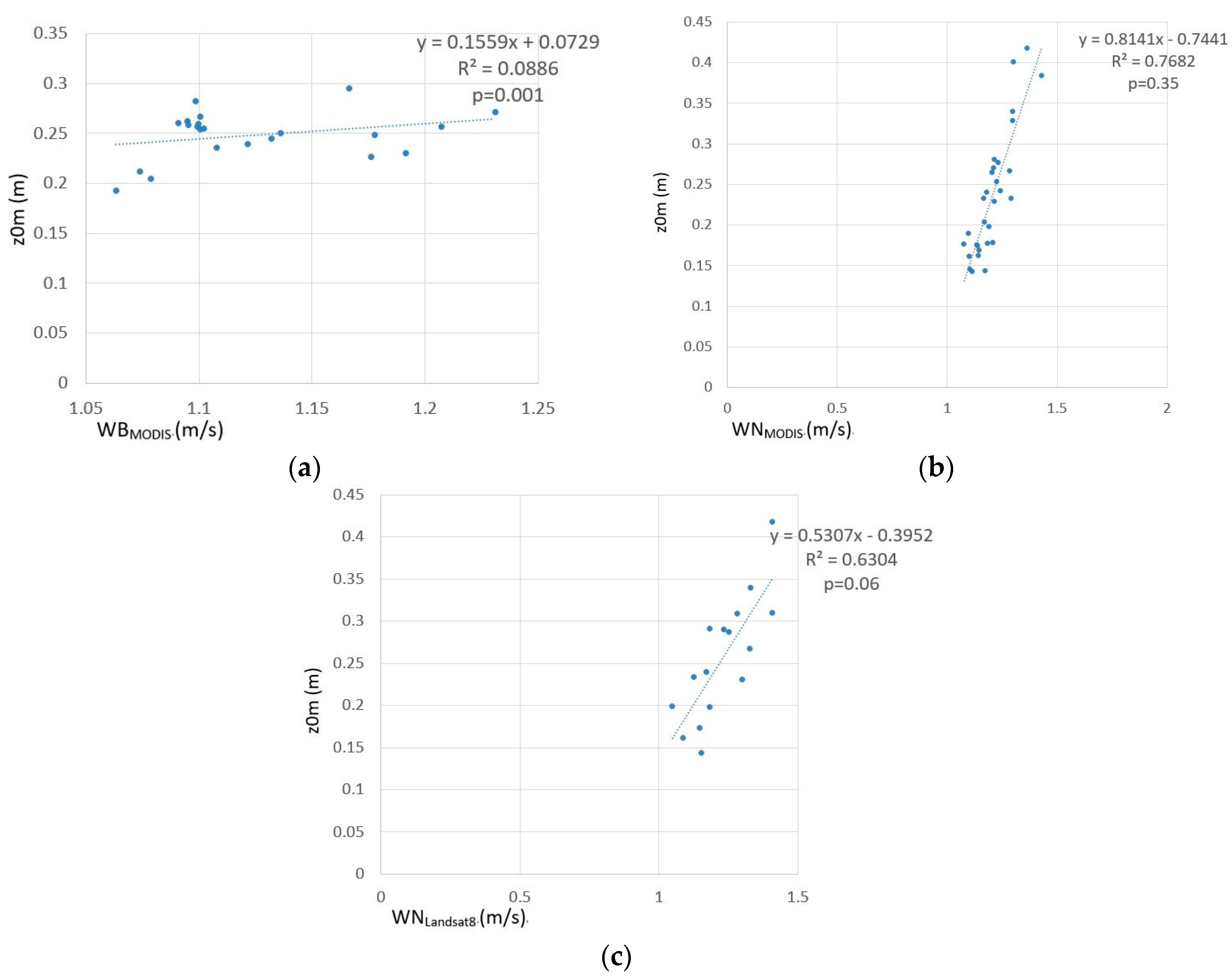
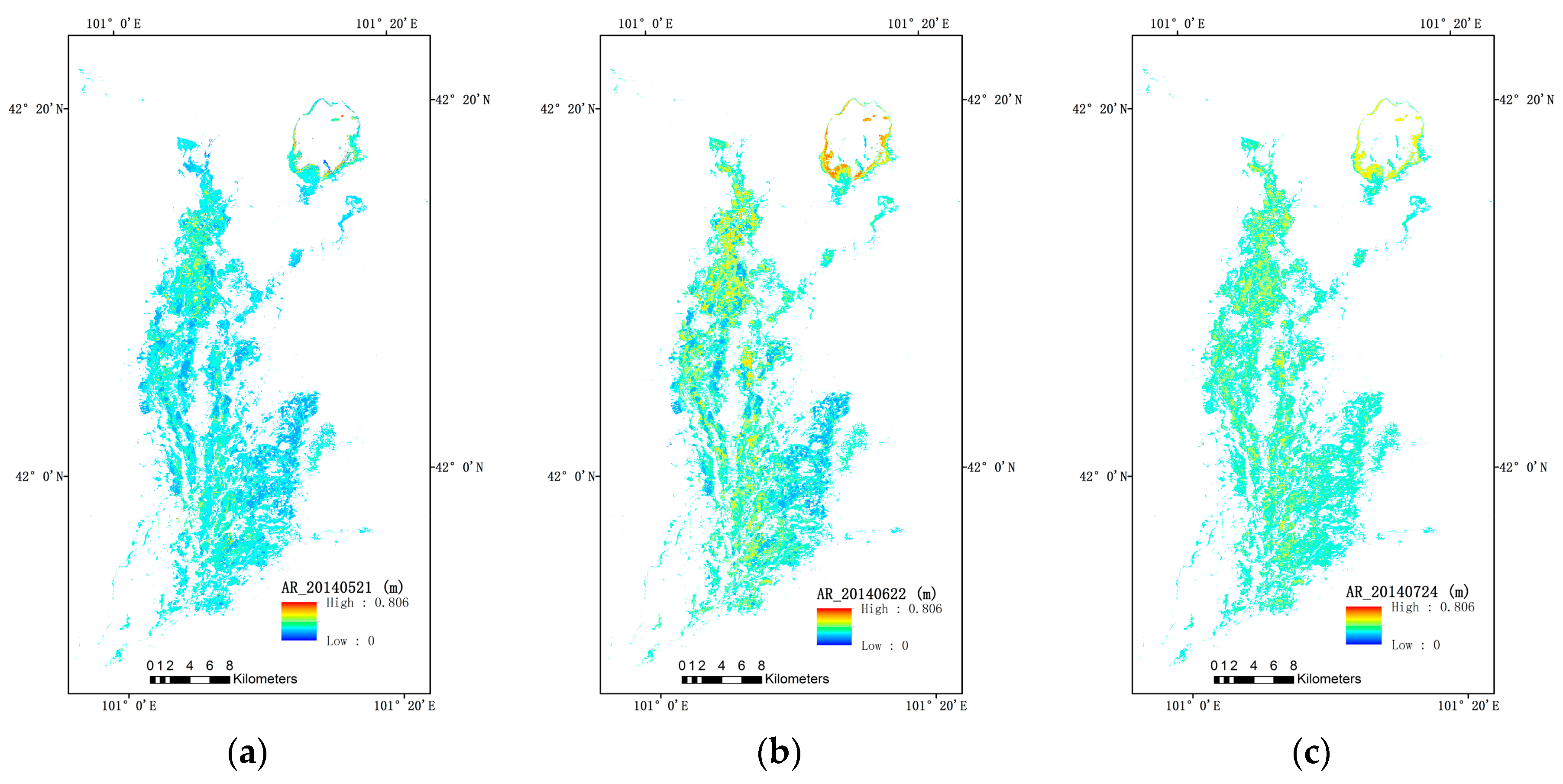
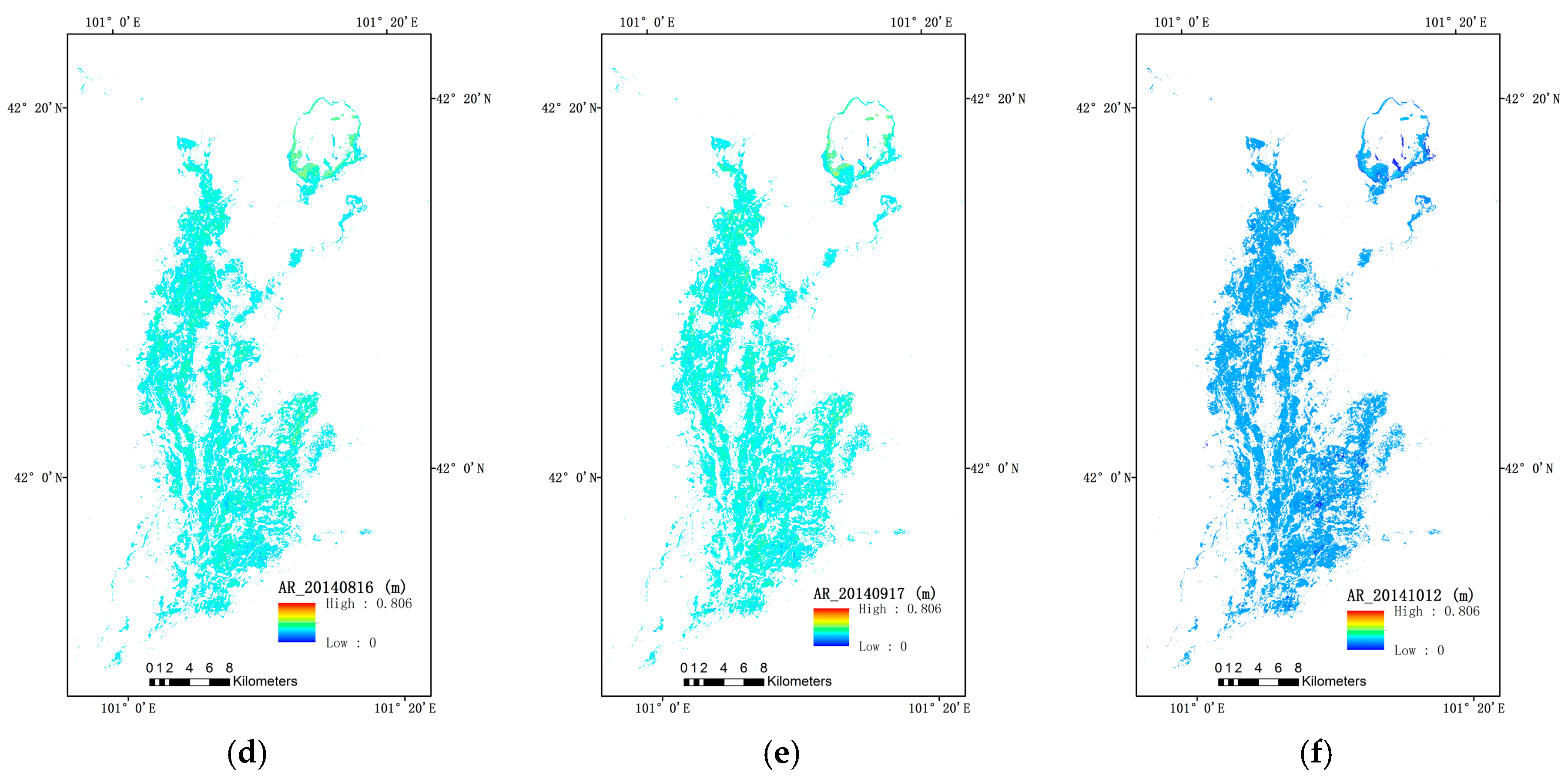
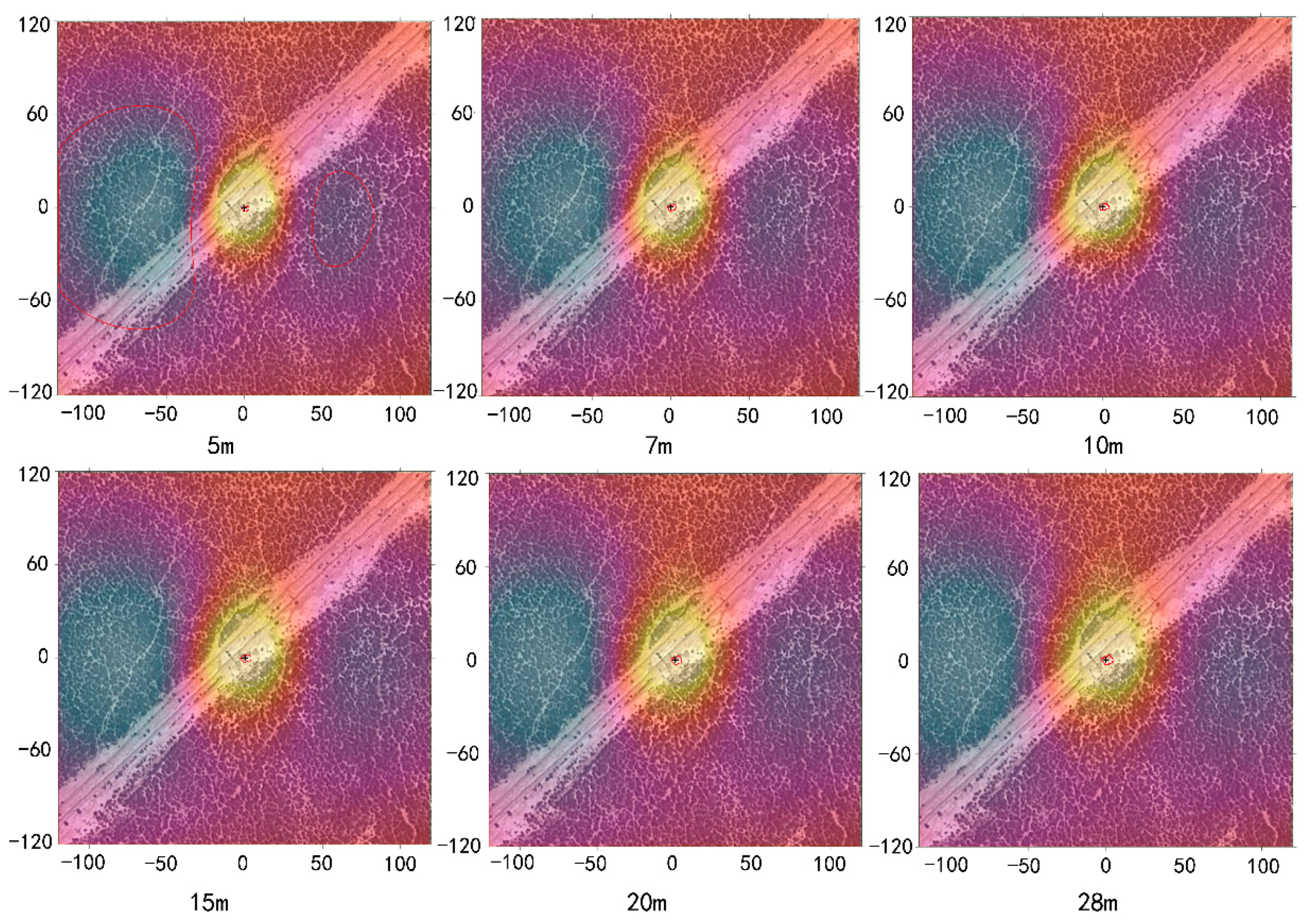
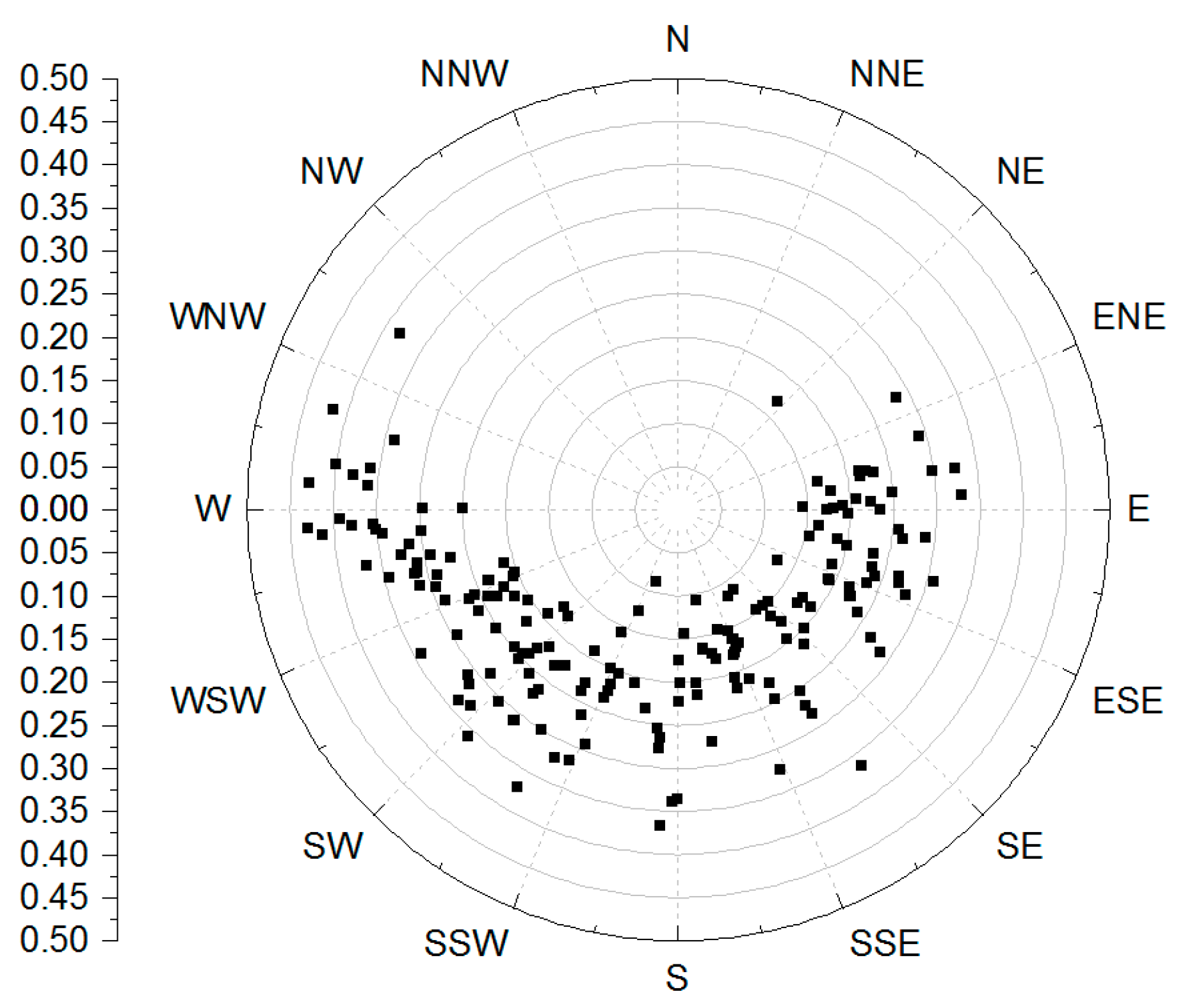

| Item | Instrument |
|---|---|
| Air temperature and humidity | HMP45C, Vaisala, Vaisala Oyj, Vanha Nurmijärventie 21, 01670 Vantaa, Finland; AV-14TH, Avalon, 35-1802 River Drive South, Jersey City, NJ 07310, USA |
| Wind speed and direction | 03002, R.M. Young, 2801 Aero Park Drive, Traverse City, Michigan 49686, USA; Windsonic, Gill, Saltmarsh Park, 67 Gosport Street, Lymington, Hampshire, UK |
| Air pressure | Model 278, Setra, 159 Swanson Rd., Boxborough, MA 01719, USA; PTB210, Vaisala, Vaisala Oyj, Vanha Nurmijärventie 21, 01670 Vantaa, Finland |
© 2018 by the authors. Licensee MDPI, Basel, Switzerland. This article is an open access article distributed under the terms and conditions of the Creative Commons Attribution (CC BY) license (http://creativecommons.org/licenses/by/4.0/).
Share and Cite
Xing, Q.; Wu, B.; Yan, N.; Yu, M.; Zhu, W. Sensitivity of BRDF, NDVI and Wind Speed to the Aerodynamic Roughness Length over Sparse Tamarix in the Downstream Heihe River Basin. Remote Sens. 2018, 10, 56. https://doi.org/10.3390/rs10010056
Xing Q, Wu B, Yan N, Yu M, Zhu W. Sensitivity of BRDF, NDVI and Wind Speed to the Aerodynamic Roughness Length over Sparse Tamarix in the Downstream Heihe River Basin. Remote Sensing. 2018; 10(1):56. https://doi.org/10.3390/rs10010056
Chicago/Turabian StyleXing, Qiang, Bingfang Wu, Nana Yan, Mingzhao Yu, and Weiwei Zhu. 2018. "Sensitivity of BRDF, NDVI and Wind Speed to the Aerodynamic Roughness Length over Sparse Tamarix in the Downstream Heihe River Basin" Remote Sensing 10, no. 1: 56. https://doi.org/10.3390/rs10010056




